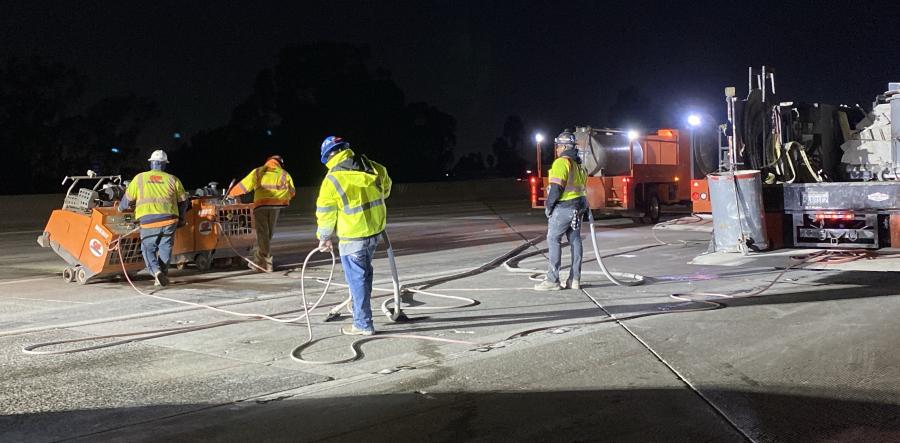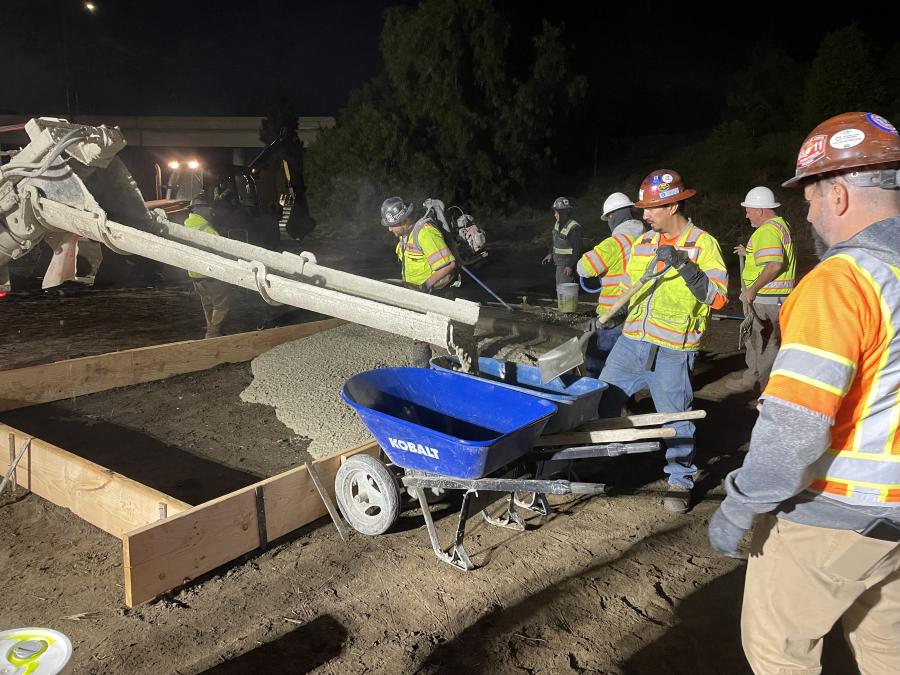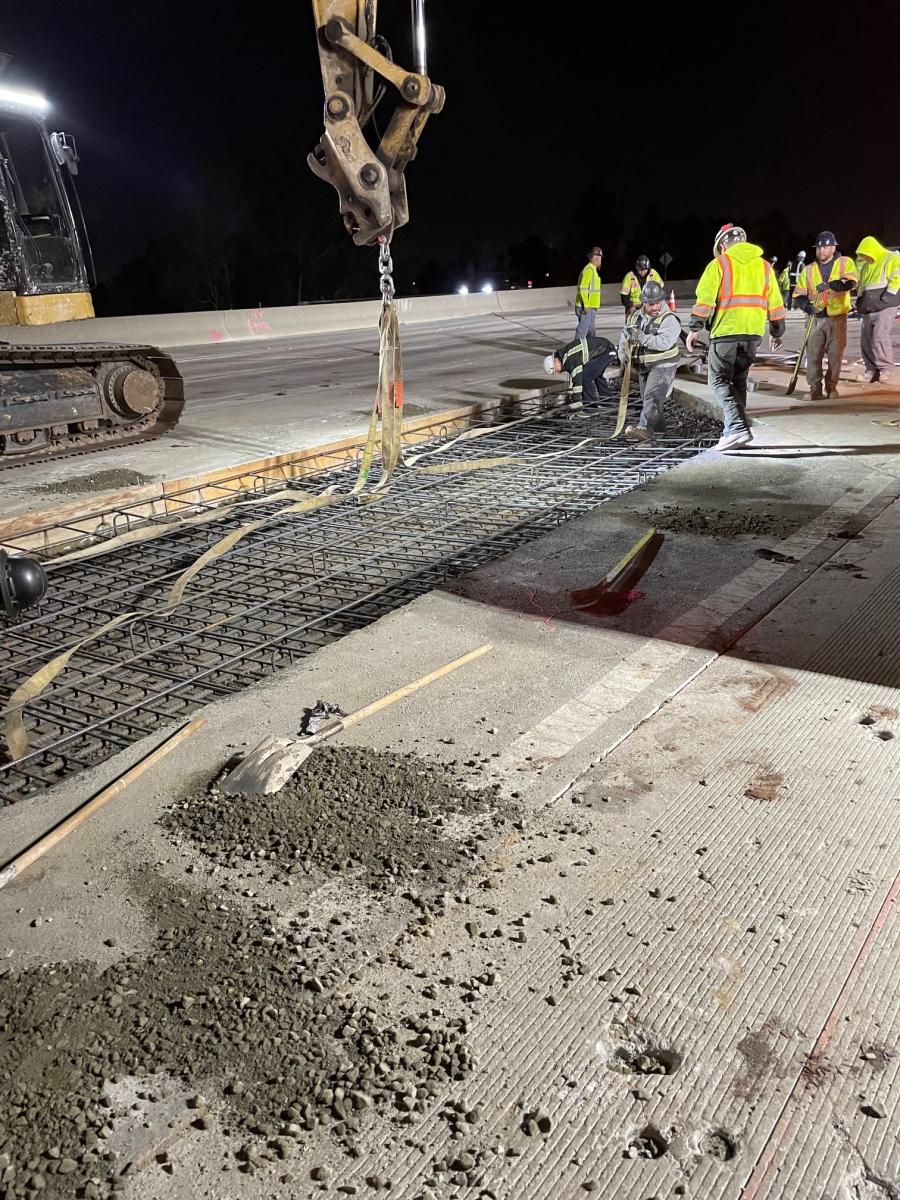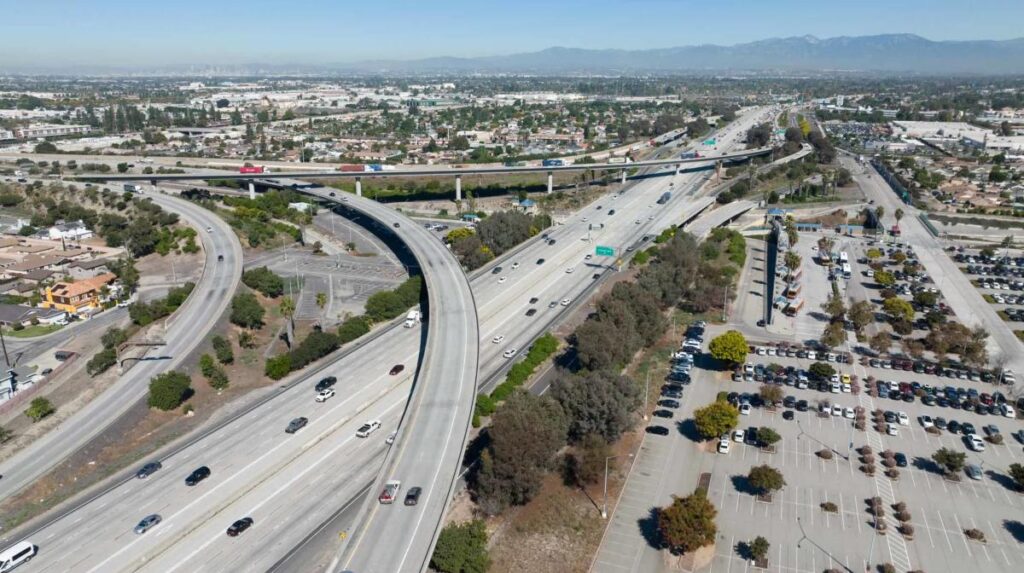Photo courtesy of Caltrans
The joint-venture of C.A. Rasmussen Inc. and FDB Vanguard Construction Inc. are taking on the $72.7 million Segment 1 of the I-605 Freeway Enhancement Project and Peterson-Chase General Engineering Construction Inc. began work on the $24.5 million Segment 2 a few weeks ago.
Construction on the California Department of Transportation’s (Caltrans) $298 million I-605 Freeway Enhancement Project began in late October last year, with a joint-venture of C.A. Rasmussen Inc. and FDB Vanguard Construction Inc. taking on $72.7 million Segment 1; and Peterson-Chase General Engineering Construction Inc. began work on the $24.5 million Segment 2 a few weeks ago.
Divided into three segments, the project will extend the I-605 pavement life by up to 40 years, reduce costly repairs, provide a smoother ride for motorists and trucks and create a safer environment for Caltrans workers by reducing the frequency and duration of time in the work zone for pavement maintenance.
“Over the next 12 months, the contractors will be working on placing K-rail and constructing Biostrip, bioswales, drainage systems, curb ramps and freeway concrete slab replacement,” stated the JV team. “We feel that this project will run smoothly and anticipate completing the designed work in a timely manner.”
The project was initiated to improve commuter travel and freight movement by rehabilitating I-605 from Long Beach to the San Gabriel Valley in Los Angeles County. Work on segment 1 has focused on installing K-rail, crash cushions and replacing concrete slabs. Segment 2 operations have crews performing initial irrigation and electrical work. Segment 3 is expected to start in spring 2024.
Segment 1
Segment 1, covering 10.1 mi. between Katella Avenue in Los Alamitos/Long Beach to Telegraph Road in Santa Fe Springs, is expected to be delivered in early 2028.
The work features the replacement of aging or damaged pavement and concrete, including repaved roadway, upgraded pedestrian curb ramps, new road signage, freshly painted highway dividing lines and application of a safety enhancing anti-skid treatment to ramps and connectors.
“The 2016 Pavement Condition Survey for this segment of the freeway characterizes the roadway as having minor pavement structural damage and acceptable ride quality,” said Marc Bischoff, a District 7 Caltrans public information officer, Los Angeles and Ventura Counties. “The condition continued to deteriorate from 2015 to 2023. For freeway slabs, we have third stage cracking for 5 percent of the slabs and replacement of these slabs is part of this project. The project was originally scoped as a Pavement Resurfacing and Restoration on June 21, 2017, as part of the approved Project Scope Summary Report [PSSR].
“This project is to preserve and extend the life of existing pavement,” he added. “This project will improve the overall ride quality, safety and operational performance of the I- 605 corridor.”
Segment 2
Segment 2, covering 5.8 mi. between I-10 to the I-605 terminus north of I-210, should be finished by fall 2026.
In addition to pavement and concrete rehabilitation, the efforts include new pedestrian signals and upgrades to six traffic lights, the construction of eight new maintenance vehicle turnouts, the installation of more than 12,000 ft. of new guardrail and replacement of 27 overhead highway signs.

Photo courtesy of Caltrans
Like Segment 1, “the condition continued to deteriorate from 2015 to 2023,” Bischoff said of Segment 2. “For freeway slabs, we have third stage cracking for 16 percent of the slabs and replacement of these slabs is part of this project. The Project Initiation Report to request programming in the 2018 SHOPP was approved on June 21, 2017. The Project Report approved on Dec. 16, 2018, and the plans were prepared from late 2018 to June 2022.
“This project is to preserve and extend the life of existing pavement and improve traffic operations and mitigate the existing congestion and alleviate the potential queue back up from the southbound Arrow Highway off-ramp to the I-605 mainline,” he added. “This project will improve the overall ride quality, safety and operational performance of the I-605 corridor.”
Segment 2 also was designed by Caltrans engineers. Similar to segment 1, there were no design and engineering challenges.
“This project not only extends the pavement life, but it treats surface runoff by incorporating the construction of Design Pollution Prevention Infiltration Areas [DPPIA],” said Bischoff. “There are DPPIAs at 13 locations and Biofiltration strips at two locations. This project also upgrades metal beam guard rails and ADA curb ramps at ramp intersections.”
Segment 3
Segment 3, from Telegraph Road in Santa Fe Springs to I-10, is expected to start in spring 2024 and be completed in early 2030. The $201.1 million will cover pavement and concrete rehabilitation and the construction of 93 lane mi. of new pavement, upgrading more than 16,000 ft. of aging or damaged guardrail, replacing 16 overhead highway signs; 53 acres of landscaping and stormwater improvements to help prevent trash and other pollutants from draining into the San Gabriel River.

Photo courtesy of Caltrans
The three segments go beyond providing a smoother ride for motorists.
“They increase visibility of road signage, create more space for maintenance workers, add new signals to increase accessibility for pedestrians and bicyclists and prevent pollutants from damaging the environment,” said Bischoff. “The department’s ‘fix it first’ approach uses state-of-the-art pavement rehabilitation techniques to quickly make repairs to road surfaces where they are needed most, minimizing costs, delays and repair frequency.”
The JV is bringing in many subcontractors, including ACE Fence Company for metal beam guard rail; Truesdell Corp for high friction surface treatment); BC Traffic Specialist for roadside signs; G&F Concrete Cutting for sawcutting; Cal Stripe for striping; R-Help Construction for drainage work; 3P Construction for electrical work; Global Road Sealing for joint sealing; Maneri Traffic Control for traffic control; RV Concrete for concrete; and Camblin Steel, which is supplying the rebar.
Project’s Need
“Caltrans is aggressively upgrading and rebuilding our infrastructure in California, including pavement rehabilitation on major interstate routes that transport goods and connect local communities,” said Caltrans Director Tony Tavares. “The department and our federal partners are making a significant investment to rebuild and maintain our state highway system and provide users with a best-in-class experience.”

Photo courtesy of Caltrans
“I-605 is a major artery for residents of the Gateway cities and the San Gabriel Valley and is a vital resource for commuters and the movement of goods throughout Southern California,” said District 7 Director Gloria Roberts. Made possible by federal funding and continued support from SB 1, these projects will also lengthen the service life of this key thoroughfare.”
Caltrans engineers designed this project.
“There were no design or engineering challenges since this a typical pavement resurfacing and restoration project that Caltrans designs and performs regularly,” said Bischoff.
Construction on any major highway in LA County area impacts traffic flow, which already has congestion during rush hours.
“While most of the repaving on these projects will occur at night, motorists can anticipate occasional daytime and weekend closures,” states a project release. “Caltrans will provide updates to the project schedules that affect travel to the public in advance.”
Caltrans describes the IIJA, also known as the “Bipartisan Infrastructure Law,” as a “once-in-a-generation investment in the nation’s infrastructure to improve the sustainability and resiliency of the country’s energy, water, broadband and transportation systems.”
Since November 2021, California has received more than $22.5 billion in federal infrastructure funding.
“That includes more than $15.5 billion in federal transportation funding to upgrade the state’s roads, bridges, rail, public transit, airports, electric vehicle charging network, ports and waterways,” said Bishoff. “These transportation investments alone have already created nearly 48,000 jobs. The influx of federal funding is in addition to California’s multiyear infrastructure investments in transit and intercity rail projects, safe walking and biking options, and upgrades to the state’s economy-powering supply chain, in addition to SB 1, which provides $5 billion in transportation funding annually that is shared about equally between state and local agencies.
“Road projects progress through construction phases more quickly based on the availability of SB 1 funds, including projects that are partially funded by SB 1,” he added. CEG
Read the full article here











